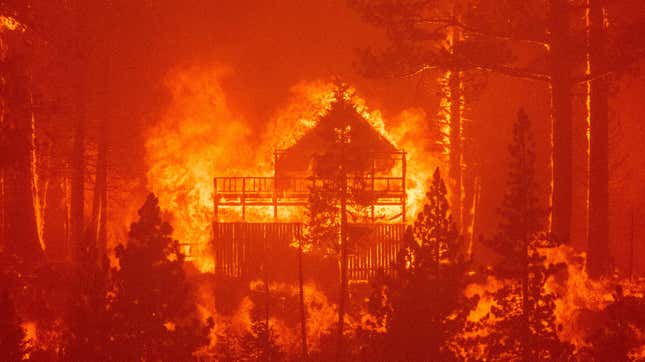
The Caldor Fire has gone from bad to worse. The flames have raced into the Lake Tahoe Basin, forcing more than 50,000 residents under mandatory evacuation orders in both California and Nevada to flee.
The start of the week has seen the Caldor Fire balloon in size, as powerful winds and low humidity fanned the flames. The blaze climbed over the top of the Sierra Nevada, California’s tallest mountain range, and has crawled into the communities on the outskirts of South Lake Tahoe. As of Monday night, the fire had consumed 186,568 acres and was at just 15% containment.
Orders went out for all 22,000 residents of South Lake Tahoe to evacuate and an additional 31,000 people across California’s El Dorado, Amador, and Alpine counties have also been forced to flee as well. Late Monday, evacuation warnings were also imposed for parts of Douglas County, Nevada, which sits on the eastern shore of Lake Tahoe. It marks the first evacuation orders in the basin since 2007.
With so many people trying to escape at once, traffic across a several-mile stretch of Highway 50 came to a standstill in the afternoon. One resident, Mel Smothers, left his car, pulled out a violin, and began to play to pass the time in what is one of the increasingly eerie and haunting scenes to emerge from the fire’s frontlines.
The Caldor Fire has destroyed at least 664 structures and thousands more under threat in the densely populated area of South Lake Tahoe. Nearly 3,800 firefighters are trying to hold the fire in check, constantly tamping out spot fires from embers being swept up to a mile (1.6 kilometers) from the fire front by powerful winds. Scott Stephens, a professor of fire science at the University of California, Berkeley, told the Sacramento Bee that embers falling from the crest of the Sierras will “no doubt” cause spot fires in the valley. If they fall on the wood cabins and other buildings nestled into South Lake Tahoe, it could create an urban conflagration in the middle of the forest.
As a precaution against more fires igniting and people being trapped in harm’s way, the Forest Service announced on Monday that it will close all national forests in California for two weeks starting on Wednesday. The same day, the governors of both California and Nevada also declared states of emergency.
“Every canyon will burn in this state,” Cal Fire Chief Thom Porter said at a news conference on Monday. “Be ready now.”
Until two months ago, no fire in recorded history had ever crested the Sierras. But the Caldor Fire now joins the Dixie Fire as the second. Last year, the East Troublesome Fire performed a similar feat in Colorado. It’s a symptom of the climate crisis, which has heated up the planet, allowing fires to climb with increasing regularity to areas once rarely burnable.
Both the Caldor and Dixie Fires, along with dozens of other blazes, are driving California’s record-breaking fire season. Last year, the state saw its worst fire season ever, yet this year’s wildfires are outpacing that—and the peak of fire season is yet to come. This is the climate crisis in full color, and if we don’t halt fossil fuel production and draw down our greenhouse gas emissions, in the future, it will get even worse.